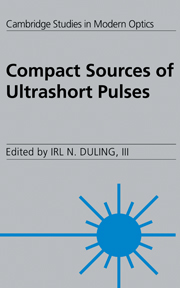Book contents
- Frontmatter
- Contents
- List of contributors
- Acronyms and abbreviations
- Preface
- 1 Short pulse generation
- 2 Passive modelocking in solid state lasers
- 3 Compact modelocked solid state lasers pumped by laser diodes
- 4 Modelocking of all-fiber lasers
- 5 Nonlinear polarization evolution in passively modelocked fiber lasers
- 6 Ultrafast vertical cavity semiconductor lasers
- 7 High power ultrafast semiconductor injection diode lasers
- 8 The hybrid soliton pulse source
- 9 Monolithic colliding pulse modelocked diode lasers
- Index
7 - High power ultrafast semiconductor injection diode lasers
Published online by Cambridge University Press: 20 January 2010
- Frontmatter
- Contents
- List of contributors
- Acronyms and abbreviations
- Preface
- 1 Short pulse generation
- 2 Passive modelocking in solid state lasers
- 3 Compact modelocked solid state lasers pumped by laser diodes
- 4 Modelocking of all-fiber lasers
- 5 Nonlinear polarization evolution in passively modelocked fiber lasers
- 6 Ultrafast vertical cavity semiconductor lasers
- 7 High power ultrafast semiconductor injection diode lasers
- 8 The hybrid soliton pulse source
- 9 Monolithic colliding pulse modelocked diode lasers
- Index
Summary
Introduction
The generation of ultrafast optical pulses from semiconductor diode lasers is extremely attractive owing to the compact and efficient properties of these devices. Applications of these devices range from photonic switching (Smith, 1984), electro-optic sampling (Valdmanis et al., 1982; Valdmanis et al., 1983), optical computing (Miller, 1987; Miller, 1989), optical clocking (Delfyett et al., 1991), applied nonlinear optics (Miller et al., 1983), and other areas of ultrafast laser technology (Delfyett et al., 1991). There have been many recent advances in ultrafast pulse generation from diode lasers in the past few years, with many researchers concentrating on device fabrication, device physics, theoretical modeling and systems applications.
In the past, picosecond optical pulse generation from diode lasers has been accomplished by modelocking and gain switching techniques (Ho et al., 1978; Ito et al., 1979). Several researchers have used degraded semiconductor lasers, which rely on defects in the semiconductor to provide a mechanism for passive modelocking (Ippen et al., 1980; van der Ziel et al., 1981; Yokoyama et al., 1982). The pulses produced from these systems ranged from a few picoseconds to just under a picosecond. The drawback with utilizing degraded diodes is that the lifetime of these devices is limited, typically several hours. Proton implanted multiple quantum well structures (MQW) have been used to passively modelock semiconductor lasers, producing pulses of 1.6 ps in duration which were then compressed to 0.83 ps (Silberberg et al., 1984; Smith et al., 1985; Silberberg and Smith, 1986).
- Type
- Chapter
- Information
- Compact Sources of Ultrashort Pulses , pp. 274 - 328Publisher: Cambridge University PressPrint publication year: 1995
- 2
- Cited by



